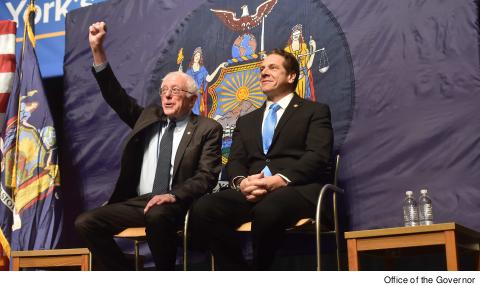Not enough funding for program
 |
Governor Andrew Cuomo’s first policy proposal of his 2017 legislative agenda was unveiled on January 3 at LaGuardia Community College – to provide free tuition for full-time SUNY and CUNY students from households earning less than $125,000 a year. Beside him was not a bureaucrat or an aide, but the new patron saint of revived New Deal liberalism, independent US Senator Bernie Sanders from Vermont, who ran for president last year on a social democratic platform that included a national free college program.
DETAILS, DETAILS
Cuomo’s new Excelsior Scholarship is hardly that. For the governor, rumored to be planning a run for the White House in 2020, the move, if successful, would – on paper – add to a list of progressive accomplishments that include securing a $15 hourly minimum wage for many workers, instituting marriage equality and banning fracking. But for many public education advocates, the proposal leaves many key questions unanswered, many that are likely to be asked and discussed once the state assembly and senate higher education committees hold hearings later this year.
Firstly, around the state, lawmakers and editorial boards questioned the dollar figure assigned to the $163 million plan. “If it’s so little, why haven’t we done it before?” asked Democrat Deborah J. Glick, chair of the assembly’s higher education committee. Assemblyman James Skoufis told Clarion, “there should be a ‘b’ next to that number not an ‘m.’” While the governor, whose executive budget included an extra $1 billion for education, called the initial figure a “rounding error,” the figure seemed woefully low in the eyes of CUNY advocates who say it wouldn’t solve the state’s underfunding of both the SUNY and CUNY system, especially after the governor’s willingness to threaten a $485 million state funding cut to CUNY just last year. For PSC members, what is needed is full investment from the state for the long term. Sharon Utakis, PSC chapter chair at Bronx Community College, told Clarion, “CUNY needs to be fully funded to make sure that our students get a quality education, which requires, among other things, fairly paid faculty and staff with secure positions.”
And that’s where the trouble really starts. According to PSC research, this is a deferred payment program in which students receive scholarships after completing 15 credits while maintaining a C average, and only then does the college get paid. If a student fails, the college, operating already on a tight budget, must eat the cost or bill the student. This comes as the governor announced an executive budget that adds virtually no new state funding to CUNY senior or community colleges.
The governor’s proposal is the result of political pressure from grassroots efforts pushing for more public university affordability in the state, and from legislative moves to reduce student costs by Assemblyman Skoufis and City Council Higher Education Committee Chair Inez Barron. Assemblyman Skoufis welcomed the governor’s move, but noted that their plans differed – for example, the assemblyman’s bill would require that graduates who take advantage of a tuition waiver live in New York State for five years, and require that if they leave, they repay their waiver like a student loan. “The logic being that if we’re going to invest in you as a student, we don’t want to see you pick up your stakes and leave after graduating,” he said in a phone interview. “That’s an element worth discussing.”
An increase in state funding for higher education is critical, because for two-year colleges this move potentially places a larger cost burden on New York City.
EDITORIAL DISSENT
“Making higher education affordable for all must entail more than a shift in expenses from students to state,” said an editorial from the Democrat and Chronicle of Rochester, New York. “It is critical that our public universities implement innovative and equally progressive measures to stem rising costs and increase accessibility in the 21st century.”
Newsday editors wrote, “This is not an open-enrollment plan; there’s no requirement for schools to accept more students. But the plan expects more students to graduate on time. That could strain resources like faculty, classrooms, labs and materials.”
The article continued, “Even with free tuition, students have to be committed to an education funded by taxpayers. Cuomo’s deal would cover full-time students, and pay for four years, incentivizing on-time graduation. And the free ride wouldn’t extend to room, board, books or fees. Whether those factors would be enough skin in the game remains to be seen.”
OTHER COSTS
That last point is key, as the college board noted that room and board costs on average exceed tuition costs nationally for two- and four-year public colleges, and the costs for text books averages $1,300, while the annual cost for transport to and from school average more than $1,000. Northeast Director for the Young Invincibles Kevin Stump wrote in Gotham Gazette that the proposal is mainly “backfilling aid after state and federal grants, and therefore the program does not help low-income students who already have the full costs of their tuition covered by Pell and TAP but struggle to afford other expenses associated with earning a degree, such as books, childcare, housing, transportation and more.”
As Assemblyman Skoufis noted, his competing bill would cover some non-tuition expenses. “My approach is a little bit pricier as a result, but I think it’s more progressive,” he said.
LOOK AT TAX BREAKS
Noting these points, Robert Samuels, author of Why Public Higher Education Should Be Free wrote in Inside Higher Ed, “The plan also does not deal with huge federal and state tax breaks related to higher education that often go to the wealthiest families. In fact, New York State already spends over $240 million a year on tax credits and deductions for tuition, and more money is sheltered from taxes through the use of 529 College Savings Plans.”
In addition, since the scholarship would only apply for full-time students, this wouldn’t help a low-wage worker seeking a degree but without the financial resources to attend school full time. Like TAP’s failure to provide assistance to part-time students this provision is deeply regressive: an 18-year-old Bronx Science graduate from a low six-figure home would could get a tuition-free full-time admittance, whereas a middle-aged worker with a high school diploma looking for economic advancement gets no aid to take advantage of what is, in essence, a public resource.
As University Student Senate Vice Chair for Legislative Affairs Hercules Reid said in a statement, “We need a plan that takes all New Yorkers into consideration.”

